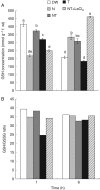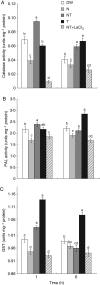Genome-wide analysis of thiourea-modulated salinity stress-responsive transcripts in seeds of Brassica juncea: identification of signalling and effector components of stress tolerance
- PMID: 20736293
- PMCID: PMC2958782
- DOI: 10.1093/aob/mcq163
Genome-wide analysis of thiourea-modulated salinity stress-responsive transcripts in seeds of Brassica juncea: identification of signalling and effector components of stress tolerance
Abstract
Background and aims: Abiotic stresses including salinity are the major constraints to crop production. In this regard, the use of thiourea (TU) in imparting salinity-stress tolerance to Indian mustard (Brassica juncea) has been demonstrated earlier. To gain an insight into the mechanism of TU action, various molecular and biochemical studies were conducted.
Methods: Microarray analysis was performed in seeds subjected to distilled water (control), 1 m NaCl, 1 m NaCl + 6·5 mm TU and 6·5 mm TU alone for 1 h. Real-time PCR validation of selected genes and biochemical studies were conducted under similar treatments at 1 h and 6 h.
Key results: The microarray analysis revealed a differential expression profile of 33 genes in NaCl- and NaCl + TU-treated seeds, most of which are established markers of stress tolerance. The temporal regulation of eight selected genes by real-time PCR indicated their early and co-ordinated induction at 1 h in NaCl + TU only. Besides, NaCl + TU-treated seeds also maintained a higher level of abscisic acid, reduced to oxidized glutathione (GSH : GSSG) ratio and activities of catalase, phenylalanine ammonia lyase and glutathione-S-transferases, as compared with that of NaCl treatment. The addition of LaCl(3) (a specific calcium-channel blocker) restricted the responses of TU both at molecular and biochemical level suggesting the possible involvement of a cytosolic calcium burst in the TU-mediated response. The TU-alone treatment was comparable to that of the control; however, it reduced the expression of some transcription factors and heat-shock proteins presumably due to the stabilization of the corresponding proteins.
Conclusions: The TU treatment co-ordinately regulates different signalling and effector mechanisms at an early stage to alleviate stress even under a high degree of salinity. This also indicates the potential of TU to be used as an effective bioregulator to impart salinity tolerance under field conditions.
Figures






Similar articles
-
Thiourea priming enhances salt tolerance through co-ordinated regulation of microRNAs and hormones in Brassica juncea.Sci Rep. 2017 Apr 6;7:45490. doi: 10.1038/srep45490. Sci Rep. 2017. PMID: 28382938 Free PMC article.
-
Thiourea modulates the expression and activity profile of mtATPase under salinity stress in seeds of Brassica juncea.Ann Bot. 2009 Feb;103(3):403-10. doi: 10.1093/aob/mcn229. Epub 2008 Nov 25. Ann Bot. 2009. PMID: 19033283 Free PMC article.
-
Thiourea orchestrates regulation of redox state and antioxidant responses to reduce the NaCl-induced oxidative damage in Indian mustard (Brassica juncea (L.) Czern.).Plant Physiol Biochem. 2011 Jun;49(6):676-86. doi: 10.1016/j.plaphy.2011.02.016. Epub 2011 Feb 24. Plant Physiol Biochem. 2011. PMID: 21421325
-
Thiourea, a ROS scavenger, regulates source-to-sink relationship to enhance crop yield and oil content in Brassica juncea (L.).PLoS One. 2013 Sep 18;8(9):e73921. doi: 10.1371/journal.pone.0073921. eCollection 2013. PLoS One. 2013. PMID: 24058504 Free PMC article.
-
Potential Mechanisms of Abiotic Stress Tolerance in Crop Plants Induced by Thiourea.Front Plant Sci. 2019 Oct 29;10:1336. doi: 10.3389/fpls.2019.01336. eCollection 2019. Front Plant Sci. 2019. PMID: 31736993 Free PMC article. Review.
Cited by
-
Cold tolerance in thiourea primed capsicum seedlings is associated with transcript regulation of stress responsive genes.Mol Biol Rep. 2012 Dec;39(12):10603-13. doi: 10.1007/s11033-012-1948-6. Epub 2012 Oct 9. Mol Biol Rep. 2012. PMID: 23053959
-
A Plant Based Modified Biostimulant (Copper Chlorophyllin), Mediates Defense Response in Arabidopsis thaliana under Salinity Stress.Plants (Basel). 2021 Mar 25;10(4):625. doi: 10.3390/plants10040625. Plants (Basel). 2021. PMID: 33806070 Free PMC article.
-
Thiourea and hydrogen peroxide priming improved K+ retention and source-sink relationship for mitigating salt stress in rice.Sci Rep. 2021 Feb 4;11(1):3000. doi: 10.1038/s41598-020-80419-6. Sci Rep. 2021. PMID: 33542250 Free PMC article.
-
Foliar Application of Sulfur-Containing Compounds-Pros and Cons.Plants (Basel). 2023 Nov 7;12(22):3794. doi: 10.3390/plants12223794. Plants (Basel). 2023. PMID: 38005690 Free PMC article. Review.
-
Thiourea priming enhances salt tolerance through co-ordinated regulation of microRNAs and hormones in Brassica juncea.Sci Rep. 2017 Apr 6;7:45490. doi: 10.1038/srep45490. Sci Rep. 2017. PMID: 28382938 Free PMC article.
References
-
- Aebi H. Catalase in vitro. Methods in Enzymology. 1984;105:121–26. - PubMed
-
- Anterola AM, Lewis NG. Trends in lignin modification: a comprehensive analysis of the effects of genetic manipulations/mutations on lignifications and vascular integrity. Phytochemistry. 2002;61:221–294. - PubMed
-
- Costa MA, Collins RE, Anterola AM, Cochrane FC, Davin LB, Lewis NG. An in silico assessment of gene function and organization of the phenylpropanoid pathway metabolic networks in Arabidopsis thaliana and limitations thereof. Phytochemistry. 2003;64:1097–1112. - PubMed

